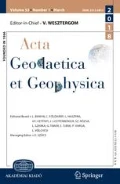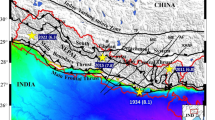Abstract
The accurate estimation of b-value of Gutenberg–Richter (GR) frequency-magnitude relationship is very crucial in seismic hazard analysis of a region. In this study, we focused on the b-value estimated by using Gumbel’s extreme distribution and GR methods for Karachi region of Pakistan. The seismotectonic setting of Karachi region is of great significant because it is surrounded by many active faults systems such as Makran subduction, Run of Kutch, Kirthar, Pab fault etc. In the past, low to moderate seismicity has been occurred in Karachi region. However, because of its seismotectonic settings there is the possibility of occurrence of major seismic event. The probability of recurrence of potential earthquake is also investigated in Karachi region. An earthquake catalogue is developed by taking moment magnitude (M w ) as a homogenous magnitude for all events. The completeness of this catalogue is done through taking instrumental data of earthquakes from 1973 onwards. A total of 530 events, occurred in 300 km surrounding of Karachi city, are selected for analysis of b-value and probability of recurrence. The regression analysis is carried out by GR-relationship to analyze the pattern of earthquake distribution and b-value. The statistical analysis of past earthquakes has computed b-value 0.49 showing inadequate earthquake events. Therefore, to find out b-value for this region with low number of earthquake, lack of data and deficiency of relevant earthquake magnitude, GR methodology is not much appropriate. In this situation, Gumbel’s extreme distribution methodology is used, which have shown better results. The regression analysis through Gumbel’s method indicates b-value of 0.8. The probability of recurrence and return periods for different magnitudes is determined by using Gumbel’s extreme distribution value approach.






Similar content being viewed by others
References
Abercrombie RE (1996) The magnitude-frequency distribution earthquakes recorded with deep seismometers at Cajon Pass, Southern California. Tectonophysics 261:1–7
Adnan A, Hendriyawan H, Marto A, Irsyam M (2005) Seismic hazard assessment for peninsular Malaysia using Gumbel distribution method. J Teknol 42:57–73
Baker WE (1846) Remarks on the Allah Bund and on the drainage of the eastern part of the Sind basin. Trans Bombay Geogr Soc 7:186–188
Betbeder-Matibet J (2008) Seismic engineering. John Wiley & Sons Inc, Hoboken
Bilham R (1998) Slip parameters for the Rann of Kachchh, 16 June 1819 earthquakes, quantified from historical accounts. Geol Soc Lond Spec Publ 146:295–319
Bilham R (2007) Seismic hazard in Karachi, uncertain past, uncertain future. Seismol Res Lett 78(6):601–613
Byrne DE, Sykes LR, Davis DM (1992) Great thrust earthquakes and aseismic slip along the plate boundary of the Makran subduction zone. J Geophys Res 97:449–478
Chen P, Bai T, Li B (2003) The b-value and earthquake occurrence period. Chin J Geophys 46(4):736–749
Gumbel EJ (1958) Statistics of extremes. Columbia University Press, New York
Gutenberg B, Richter CF (1956) Earthquake magnitude, intensity, energy and accelaration. Bull Seismol Soc Am 32(3):163–191
Khalid P, Ghazi S, Yasin Q, Khurrem S (2014) Assessment of seismic hazard of the Kalam-Ashrit Dam, Swat, Pakistan. 3rd Annual international conference on geological and earth sciences (GEOEARTH 2014), Singapore, 22–23 Sept 2104
Oldham TA (1883) Catalogue of Indian earthquakes. Geol Surv India Memoir 19:163–215
Schelling DD (1999) Frontal structural geometries and detachment tectonics of the northeastern Karachi arc, southern Kirthar range, Pakistan. Geol Soc Am Bull 328:287–302
Scordilis EM (2006) Empirical global relations converting M S and m b to moment magnitude. J Seismol 10:225–236
Tezcan SS (1996) Probability analysis of earthquake magnitudes. Turkish Earthquake Foundation, Istanbul, p 26
Tinti S, Rimondi R, Mulargia F (1987) On estimating frequency-magnitude relations from heterogeneous catalogs. Pure Appl Geophys 125:1–18
Author information
Authors and Affiliations
Corresponding author
Rights and permissions
About this article
Cite this article
Ahmed, N., Ghazi, S. & Khalid, P. On the variation of b-value for Karachi region, Pakistan through Gumbel’s extreme distribution method. Acta Geod Geophys 51, 227–235 (2016). https://doi.org/10.1007/s40328-015-0122-8
Received:
Accepted:
Published:
Issue Date:
DOI: https://doi.org/10.1007/s40328-015-0122-8




